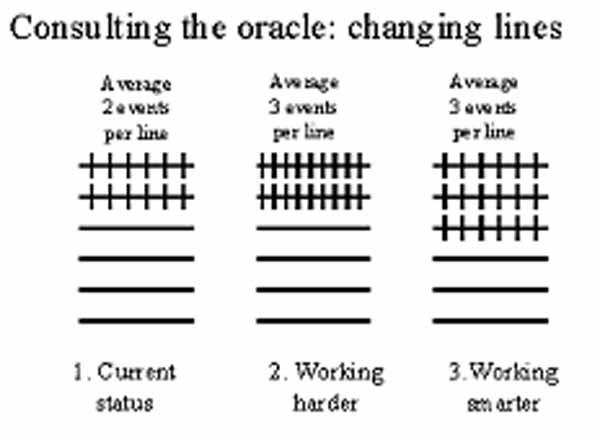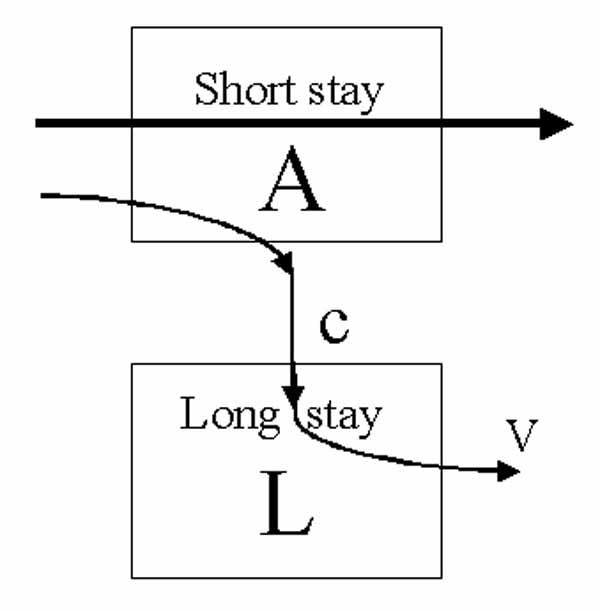Nosokinetics
Ac = Lv: how does that help me?
Peter Millard
Carl Long writes: OK. The fundamental equation is Ac = Lv, how does that help me? In our patch we do not have long stay hospital beds, only nursing home beds, and access to these is via social services unless private funding is available. In reconfiguration discussions there is talk of us having sub-acute step down beds and rehabilitation beds. Indeed, chaos theory may be more applicable to our situation!
Millard replies: Good point. Where should I begin? Before we get to chaos theory let us first consult the Oracle. Figure 1 illustrates two options for change: working harder and working smarter. Notice that, both options 2 and 3 achieve the same thing, they increase turnover to three events per line.

Fig 1. Six line hexagrams are the fundamental building block of the Chinese Book of Changes*: six lines, either continuous _____ or split __ __ , give 64 options for change. Here we use the concept to illustrate a basic premise of the behavioural theory of change.
* The I Ching or book of changes. Richard Wilhelm translation. 1951 Routledge, Kegan & Paul, London.
The two compartment flow model in Figure 2 shows the basic principles of flow of patients with time.
On any day two streams of patients, the short stay (the movers) and the longer stay patients (the stayers) enter medical beds the beds of hospital. Note, in time, patients both long and short stay patients enter on day 0.

Fig. 2. Ac = Lv is a model of patient flow in geriatric medicine.
In stable state, Ac = Lv. When Ac > Lv more long stay beds are needed, so the space for short stay patients decreases, hence fewer patients can enter acute care. Vice versa, if Ac < Lv then the space for short stay patients increases. Hence the key for control of any health and social care system lies at the interface between short stay and long stay care. See Harrison & Millard 1991, below, for the equations that underpin the mathematical model.
The benefit of having a method of analysing current bed usage, and an explanatory mathematical solution to the model of flow, is that managers and clinicians can describe what is happening and pre-test the immediate and long-term impact of changes in bed allocation and patient management.
In modeling terms short stay patients (over 80% of admissions) are 'movers' (M). The remainder, those with complex problems needing prolonged treatment, rehabilitation or alternative social placements are 'stayers' Perhaps it would be clearer, therefore, if we changed the basic equation for our discussion from Ac = Lv to Mc = Sv. For the letters 'A' and 'L' imply structure, staffing and beds, but the model concerns time of movement through the resources.
Look back at the three six line models in Figure 1. Standard hospital returns report clinical events in allocated beds. There are twelve events in model 1 and 18 events in models 2 and 3. Clearly, models 2 and 3 improved throughput and decreased length of stay using diametrically opposite internal processes, yet, using standard hospital returns (average length of stay, average emptiness and turnover per bed) clinicians and managers cannot demonstrate how their beds are being used.
Mathematically and clinically there are several plausible explanations for the problem you now face. Working harder may have changed clinical and nursing practice so the number of patients needing alternative placement and rehabilitation has increased.
Alternatively, the case mix on entry may have changed, with more dependent patients being admitted due to closure of alternative admission services elsewhere. Or, something outside the system has changed the outflow (v) from your acute medical wards. Only by analysing the flow rates through the beds could we actually tell what is happening within the beds.
Reference: Harrison, GW and Millard, PH (1991) Methods of Information in Medicine, 30, 221-8.
Some navigational notes:
A highlighted number may bring up a footnote or a reference. A highlighted word hotlinks to another document (chapter, appendix, table of contents, whatever). In general, if you click on the 'Back' button it will bring to to the point of departure in the document from which you came.Copyright (c)Roy Johnston, Peter Millard, 2005, for e-version; content is author's copyright,